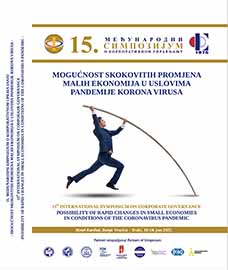TRGOVINSKI RAT IZMEĐU SJEDINJENIH AMERIČKIH DRŽAVA I KINE I NJEGOVE
TRGOVINSKE IMPLIKACIJE
THE US-CHINA TRADE WAR AND ITS TRADE IMPLICATIONS
Author(s): Katja Zajc Kejžar
Subject(s): Economy, National Economy, Micro-Economics, Marxist economics, International relations/trade, Political economy, Public Finances, Socio-Economic Research
Published by: Finrar d.o.o Banja Luka
Keywords: United States;China; global value chains; trade war;
Summary/Abstract: The introduction of new customs duties represents a serious challenge for the organisation of global value chains and current patterns of the international division of production Such measures have further weakened the already fragile fundamentals of the post 2nd World War Bretton-Wood’s multilateral system. In the last couple of years, the appeal for a reorganization of the World Trade Organization has intensified. In this paper, we aim to study trade implications of the US-China trade war from a perspective of supply chain trade and the organisation of global value chains (GVCs). We first present the development of the tariff rates in the US and China over the course of the trade war and sum up early evidence on the US-China trade war effects from stock price volatility. Next, we discuss the differences in tariff impacts on traditional and supply chain trade. We continue with characterizing the US and China’s GVC position and resulting pressure for supply chain restructuring. Finally, we look at trade effects for the EU in different categories of goods. The involvement of the EU-28in GVCs is characterized in general with a more upstream position in trade with China, while backward participation strongly prevails in the EU-28 trade with the US, with notable differences among EU member states. Trade data for the two most recent years shows a certain degree of EU trade reorientation towards both the US and China, where an increased share of exports to the US has been driven by intermediate goods, while in exports to China consumer goods showed the strongest growth. The evidence on the adjustment of GVCs in wake of the US-China trade war suggests that an increase in trade costs has important implications for the organisation and location of GVC activities. We may expect that such a trend will be further strengthened in response to the current COVID-19 pandemic situation. Trade is likely to fall more steeply in sectors characterized by complex value chain linkages. Restructuring,shortening, and reorientation of GVCs will, expectedly, be even more pronounced since the COVID-19 crisis involves lockdown and social distancing causing major labour supply shocks and GVC disruptions.
Book: 15. MEĐUNARODNI SIMPOZIJUM O KORPORATIVNOM UPRAVLJANJU
- Page Range: 107-122
- Page Count: 15
- Publication Year: 2021
- Language: Serbian
- Content File-PDF

